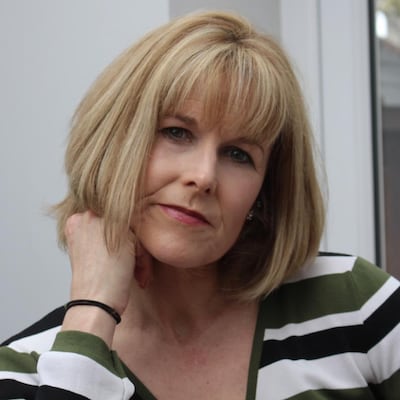Sometimes we write our earliest stories, without even realising.
Once upon a time, in what seems like a faraway land, a place we call childhood, I had a little brother. I don’t remember him coming, but I do remember him going away 2¾ years later – the ¾ had been important to him, like maybe he knew he’d never make another whole year, his 2¾-year-old lungs already too old, too little, too sick.
To a child of eight, death is unfathomable, even in stories – Grandma Hood, originally disembowelled and fed to little Red, is saved by the woodcutter. Snow White, waked in a glass coffin, kissed by a passing prince, is likewise resurrected. And they all live happily ever after. To a child of eight, people don’t die, goldfish swim away to sea, dogs go to farms, with big fields, down in Bunclody; little brothers, especially, don’t die.
I created a story around my brother's going away because it was, and still is, much easier than burying him in the cold, cold ground
And so I created a story around my brother’s going away because it was, and still is, much easier than burying him in the cold, cold ground.
I built my book M for Mammy upon an image that had somehow developed in the dark room of my imagination. There is a child, with dark hair. I can only see the back of his head, not his face. He is being driven away. I know he isn’t coming back. I stand on the footpath, waving goodbye.
I wrote a short story based on the anonymous boy in the back of a Datsun Cherry, who I called Jacob, four years ago. That story won the Francis MacManus award. Then that story became a novel. It was only very, very recently that I understood the genesis of this tale.
Because my brother had been so sick, for so long, I was partly reared by my Granny Eileen and her sister, Great-Aunt Maureen. And these were the first real-life characters I ever knew. Living in a past they both loved, they brought me there with them, through the stories they told. Rendered in black and white, because they (it seemed to me anyway) had lived in a time when there was still no colour in the world, and no cars and no telly and no electricity; when your whole family could be dead in a week because of the flu and your neighbours could be dead the next week from all the coughing and sneezing and spitting that came out of your house. These stories enchanted me.

They would talk of all those they had loved and lost, and I would find myself remembering these people too (though I only knew of them through these tales), loving each one and losing each one with every story, as I was drawn into, and threaded through, the stories of their births and deaths, of how they had lived, their lives bending and folding into each other like the ingredients of a cake; "Oh, Our Ethel. Only 13, she was . . . Cathleen died on a Monday and we were back up over that hill again, with John by Thursday . . . Our Jack sailed to America with hardly a seat in his pants . . . They had to break both his two legs, just to get him into the coffin, he was that tall . . ."
Their brothers and sisters, of whom there had been many, had either died of tuberculosis or emigrated to the United States (which amounted to much the same thing, really). Eileen and Maureen were both walkers, great long-strided walkers, and they were talkers. I remember following the harvest moon with them along the North Beach and all the wonder of it; how they danced in the dunes the long-ago ballroom steps that had won them the pewter cups on their sideboards at home, their dead siblings skipping along beside us, as did the tales, so often told, of the Pottery, and the Fur Factory, where, later, they had made chocolate.
And it was with the lovely rhythms of speech, the little rising notes and falling sounds in all the words, that brought the black-and-white faces of long ago back to life; all the dead people, turning into colour, coming back to them again, as they were named and remembered, both inside and outside of their own stories. We remember each other, and we are remembered through stories, they used to tell me.
My granny and great-aunt spent their time protecting me, spinning yarns to wrap me up in, keep me safe from this awful thing that had happened
In M for Mammy I now know the missing child is Jacob. His older sister, Jenny, tells us how Autism got in through the kitchen window they'd left open for the cat, one Wednesday in February, and took Jacob away. Jenny makes up stories to keep the truth at bay. She is desperate for a happy-ever-after ending, which she attempts to write, just in case things don't turn out as she'd hoped. And the adults around Jenny instinctively try to protect her, and probably themselves, from a truth that is so terminally painful that it is too big to comprehend. I remember being that protected child . . . He's going off to be a little angel up in heaven . . . they told me.
My granny and great-aunt spent their time protecting me, spinning yarns to wrap me up in, keep me safe from this awful thing that had happened. I grew up and away. But these two characters, who had known nothing of Trinity College Dublin or UCD, of BAs or MAs, and with hardly a completed primary education between them, were the real natural born storytellers, re-creating scenes and inventing fictions to keep the memories of those they had loved alive.
Despite all the knowledge I have acquired from professors, lecturers and writers, it was these two who were my first and, I dare say, my best teachers. It was through them that I found my voice and my story. They would have been so proud of me now. I can almost hear them say . . .Well now, let me tell you, our Eleanor is a writer, you know . . . takes after us . . . Oh, now, from the time she was a child . . .
M for Mammy by Eleanor O'Reilly is published by Two Roads




















